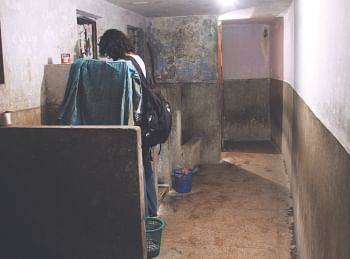| Home - Back Issues - The Team - Contact Us |
 |
| Volume 11 |Issue 14| April 06, 2012 | |
|
|
Special Feature An Urgent Need Anika Hossain
Everyone living in Dhaka knows at least one person who at some point, if not on a regular basis, has urinated in a public space. It is not an uncommon sight to see people (mostly men), using footpaths, open drains, parks, dumpsters, alleys, street corners, foot bridges and open areas inside public buildings as their own personal toilets. This practice is so commonplace that people are actually taken aback when they are asked why they don't bother finding a toilet to do their business in private. “What do you mean why? I don't know why I urinate on the footpaths,” says a surprised rickshaw-puller, “Where else would I do it in the middle of the day?” “I don't know where the public toilet is,” says a student of a private school who just finished defecating in the Dhanmondi Lake area. “I live in Mohakhali and my school is closed now,” he adds defensively. “Why shouldn't I pee in the drain? All the feces from every toilet ends up in here anyway right?” claims another public urinator. “Public toilets charge money,” says a recent college graduate, “Why pay if we can pee for free?” “But everyone does it….” trails off a slightly embarrassed middle-aged culprit. Other interviews have also proved that most people who are using public spaces as toilets are not exhibitionists (mostly) nor are they doing so for the fun of it. As one can imagine, this practice has, over time, offended many sensibilities, caused serious health hazards and has lead to many complaints around what seems to be the main reason behind the problem-- the lack of public toilets in the city.
Dhaka has a current population of over 14 million people, with a growth rate of over three percent. On top of that, at least half a million people migrate to the city from all parts of the country in search for a decent living. Most of these migrants end up in slums, but about a million or so are homeless. It is one of the fastest growing cities in the world. A study conducted by the Centre for Urban Studies and Water Aid in Bangladesh shows that in order to cater to the needs of this ever growing population, the city has only five fully operational public toilets. This means that water, urinals, electricity and other toilet facilities are available in these five joints. “We currently have 62 public toilets around the city,” says Nurul Amin, an official at the Dhaka City Corporation (DCC). The study however has a different story to tell. Although the city corporation has, in fact, built 69 public toilets and leased them out to private companies for maintenance, two of these were obstructing footpaths and therefore demolished. 10 of the remaining toilets were not operational at all. Out of the remaining 57 toilets, 10 more turned out to have no facilities other than the physical structure itself. The remaining 47 toilets are all partly operational, meaning some essential facilities are not available there. These toilets are supposed to remain open 24 hours and cater to every citizen; however, we must remember that this is a patriarchal society and women's needs, by rule, are not taken into consideration. “I have never been able to use public toilets,” says one such distressed woman. “Some of these have signs that say they are for women but men are freely using them. Also, the male cleaners and men around the place make me uncomfortable.” “I went to a public facility once and was horrified by the state of the place,” says another revolted female citizen. “There was fecal matter all around, on the floor and even on the walls. The smell was overwhelming. I have never considered using a public toilet since then.” “I would rather hold it in and get a urinary tract infection than use one of those disgusting toilets,” says another. Interestingly enough, although the general public isn't being able to use most of these structures as toilets, true to their nature, they have found alternative uses for them. “I have seen some of these toilets being used as storage places,” says one forlorn citizen. “Some are also used as small shops and eating houses,” claims another. The study found that only 14 toilets were actually used for their true purpose. “Some of our toilets are held up in litigation,” says Nurul Amin, “The cases against them are pending and therefore their maintenance and upkeep is currently not our responsibility.” Despite all these current problems, the DCC has big plans for the future of public toilets around the city. “Of course we need more toilets,” says Amin, “We plan to build 92 public toilets, they will be financed by the Bashundhara group and we will start work on them within the next six months. We hope these additional toilets will improve the situation,” he comments. Perhaps if we had a map to all the public toilets, volunteers pointing them out to the illiterate, waved the 4 taka fee for the underprivileged, and hired people to actually clean the toilets once in a while, the situation may have a slight chance of improving. In the mean time, anyone who is offended by the sight of public excretion should do their civic duty, march right up to the guilty party and give them a piece of their mind. It may not stop them, but they might at least try to keep out of sight in the future. Copyright
(R) thedailystar.net 2012 |
||||

